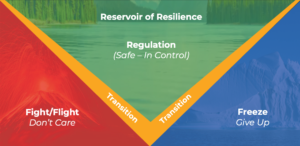
“She’s not heavy, she’s my sister – But Please, Can I Put Her Down for a Minute”
“It’s like I can’t turn it off! I live with patient concerns 24/7 because they occupy my thoughts and follow me home.”In a recent conversation, Tasha (name changed), my friend working in healthcare, shared with me that she wants a better life balance that allows her to have some “away” time from her job, her work-load concern, and her thoughts about patients.
Working in health can make it difficult to stay resilient and maintain a reasonable work-life balance. What does it mean to relax and how do you do it? These are common concerns and questions faced by those working in healthcare because the lines between work and personal life blur, and burnout creeps in.
Understanding Resilience
Resilience is often described as the ability to “bounce back” from life’s challenges, but it’s more than just recovering—it’s about adapting and learning in the face of adversity. In the medical field, where the stakes are high and the demands intense, resilience enables healthcare professionals to manage stress, maintain focus, and deliver quality care even under pressure.
The VEST Framework: A Practical Approach to Resilience
Resilience isn’t just something we’re born with—it’s a skill that must be cultivated through intentional action. We suggest “VEST” as a practical approach for engaging with tools and building connections to help enhance resilience. Through this conversation, let’s walkthrough putting on your mental health vest to face the rigors often faced by healthcare professionals:
Vigilant:
Tasha shared how she is constantly on edge, and it starts with walking into work and then follows her home. Being vigilant in this context involves being aware of how stressors impact your emotional and mental state “behind the scenes,” or understanding your hardwired system. Just as you monitor your patients’ conditions, it’s essential to monitor your own well-being and understand more fully how innate emotional responses hijack our system and “thinking” brain.
Tip: Start your day with a brief check-in. Before you dive into your rounds or start your shift, take two minutes to assess how you’re feeling. Are you carrying stress from yesterday, from home, from a relationship? Compartmentalize your feelings and look closely at what is at work “behind the scenes” in your head. Is your system being hijacked by your emotional brain? Being mindful of your emotional state helps prevent lashing out and early burnout before they escalate.
Engage:
Tasha mentioned she couldn’t seem to“turn off” her brain when she left work. I suggested she engage with a few simple resilience tools including breathing and mindfulness to move beyond raw emotion. By intentionally focusing on the present moment, you can interrupt the emotional cycle of worrying and racing thoughts. It’s about giving yourself permission to let go, even briefly, to recharge.
Tool: Practice 2-1 breathing. Inhale through your nose, one long inhale and then when it seems your lungs are full, one more last short inhale. Hold for a moment and exhale slowly. This positive“hack” technique helps reduce stress and brings clarity, especially during moments of overwhelm and helps get back to your thinking brain by reducing CO2 levels in your system and slowing your heart rate. Look at Jeff Haden’s work for a deeper dive.
Sustain:
One of the main concerns Tasha expressed was feeling isolated—like she was carrying her burden alone. In healthcare, it’s easy to feel disconnected, even when surrounded by people. Sustaining resilience means maintaining meaningful connections with those around you—both at work and at home. This support system can be a lifeline.
Tip: Write down the names of a few meaningful connections. One family member, one friend, one co-worker, and one licensed mental health clinician for example. Then make time to reach out to your connections with regularity, even if it’s just a quick coffee break or phone call. These small moments build connections with resources that will help provide emotional relief and help when you need a recharge. Remember “be a friend to have a friend.” Making yourself available to help a friend is a great way to get out of feeling stuck.
Transition:
The hardest part for Tasha was transitioning from work mode to home life. She described how difficult it was to switch gears mentally, even after she’d physically left the hospital.Transitioning effectively from states of dysregulation, or too much emotional brain, where your mind is racing, to a calm state of regulation, is crucial for your well-being. It allows you to be fully present in both your professional and personal life.
Tool: Use the 5-4-3-2-1 grounding technique to transition from the stress of work to a more regulated state when you get home. Identify 5 things you can see, 4 things you can touch, 3 things you can hear, 2 things you can smell, and 1 thing you can taste. This exercise when you arrive home and walk in the door helps get you back into the present moment where your emotional brain can turn off and leave some cycles to relax, be creative, and even solve problems.
A Continuous Journey
As our conversation ended, Tasha thanked me for listening and suggesting a few practical tips. By putting on your VEST—being vigilant about stressors, engaging with tools to manage them, sustaining meaningful connections, and transitioning back to a regulated state—you can find greater resilience to help carry you through the many challenges you face as a healthcare professional.
Healthcare is a noble and important work where you have the opportunity and burden of witnessing some of the hardest and most rewarding challenges life serves up. You deserve to enjoy your work and your life. Put on your VEST to stay at your best.

Ted Paulsen is the CEO of VEST, an employee assistance provider focused on employee resilience and support. Connect at Ted B Paulsen on LinkedIn or Ted@lecticon.com.

Ted Paulsen
My Hero’s Journey started with a plunge into a collegiate pool at BYU to support my pursuit of an accounting degree followed by a move up North to the University of Utah for a law degree. After working in Southern California, I found my way back home to Utah helping structure and fund client businesses as a securities attorney before taking a position as the COO of a growing national insurance company.
I currently serve as the CEO of Lecticon and VEST EAP where we provide clients with comprehensive cultural enhancement and employee retention solutions. We are fortunate to work with clients including Salt Lake County, Larry Miller Group, AAA Insurance, Safety National Insurance, and many first responder agencies, among many others.


